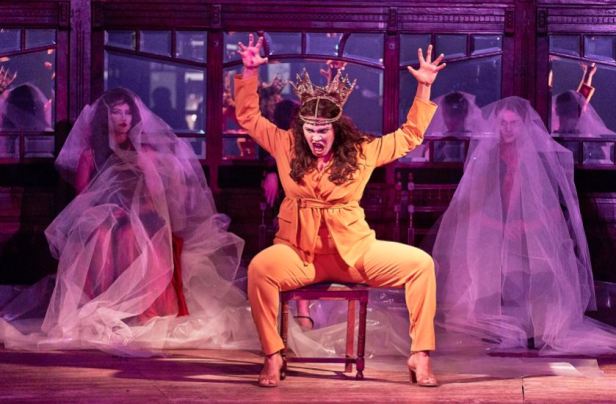WA Academy of Performing Arts 3rd Year acting students: A Midsummer Night’s Dream
The Edith Spiegeltent, WAAPA
Review: Robert Housley
Reconstitution and/or re-contextualisation are oft-used means to contemporise the Bard’s work. The extent to which these types of interpretations appeal to their audiences is dependent upon a willingness to embrace the journey.

The WA Academy of Performing Arts guest director Stefanos Rassios is renowned for reinterpreting classic works of Western drama. He explained in his program note that in his reconstruction of A Midsummer Night’s Dream he is looking to unearth fundamental ingredients of love other than comedy and tragedy. Specifically, “terror, awkwardness, pain, apathy, loneliness, confusion and hopelessness.”
“It doesn’t sound much like fun,” he continues, ”but when viewed through the prism of Theatre, we can at least appreciate the lighting? Can’t we? Or perhaps we can appreciate something …other?”
What certainly can be appreciated is that this performance featuring the entire 3rd Year Acting cohort is a theatrical prism that disperses the colours of the rainbow far and wide. It features a whole lot of the other in an eclectic mix of ingredients and devices.
What carries the show are the unwavering performances of its quality group of 17 imminent graduates. The essential Shakespearean play remains: a planned royal wedding, two pairs of star-crossed lovers in an enchanted forest full of fairies, a dodgy love potion and a group of Athenian tradesmen (so-called Mechanicals played by Adam Marks, James Thomasson, Will Bartolo, Lily Stewart, Teresa Moore and Shannon Ryan) hoping to stage a play at the wedding.
But it didn’t start well. The audience was kept standing in the nominal foyer for the first 10 minutes of the performance not quite sure when, or if, they would be ushered to their seats.
This dislocation was exacerbated when in the ensuing 15-20 minutes the actors performed behind a quadrangle of translucent plastic sheets stretched from the floor to the lighting grid. Both devices bordered on performance art wherein concept is paramount and the audience a distant consideration. There was a palpable sigh of relief when the plastic sheets were ripped from their bull clips and crashed to the floor.
What was apparent early were the challenges of staging this text-heavy play in the Spiegeltent. The voluminous space and the need to cater for an audience in almost all directions (in the round) meant the rare use of microphones throughout. Mostly corded ones that were either hand held or on mic stands. The mechanics of this was handled well.
The ‘look’ of the show (lighting design Rhys Pottinger) was dominated by the appearances of the cast (costume supervision by Eryn Burnett-Blue and Remy Benn). Many were in white face, some in various forms of period attire, some dressed in bedroom Goth (James Rankin’s Puck was Frankenfurter inspired) and several were style-blended cross-dressers.

The sound design (Matthew Clark) also was prominent, providing not only a narrative adjunct but also locating the play in modern times. Blondie’s Heart of Glass, Dolly Parton’s Jolene and the ultimate updater, zef and anarchic duo Die Antwoord’s I Fink U Freeky.
But the biggest shape-shifting experience was the Mechanicals’ performance of the so-called play-within-a-play at the triple weddings of Theseus (Michael Cameron) and Hippolyta (Mia Morrissey), Hermia (Mikayla Merks) and Lysander (Jarryd Dobson) and Helena (Kian Pitman) and Demetrius (Sam Corlett).
Tulle covered characters watched on as a Spanish bullfighter appeared, enunciating in Spanish what presumably were lines from the play. Next a ballerina en pointe tippy-toed her way across the stage before delivering her lines in French. Then a cross-dressed Geisha in jeans and kimono fanned ‘herself’ while uttering ‘her’ lines in Japanese. The reconstitution was complete when the plastic sheets were dragged back on stage to cover the mostly scattered and prostrate cast.
There is no question that this production lived up to the standard for which WAAPA is renowned. Whether the audience appreciated this reconstructed staging of a much-loved Shakespearean play is questionable. Doubtless some did, but those who left during the interval clearly did not.
A Midsummer Night’s Dream continues until 18 October at 7.30pm.